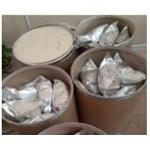- Mepiquat chloride
-

- $0.00 / 1KG
-
2025-04-22
- CAS:24307-26-4
- Min. Order: 1KG
- Purity: 98.0%
- Supply Ability: 1000kg/month
- Mepiquat Chloride
-

- $150.00 / 1kg
-
2025-04-22
- CAS:24307-26-4
- Min. Order: 1kg
- Purity: 99%
- Supply Ability: 500kg
- mepiquat chloride
-

- $0.00 / 25kg
-
2025-04-11
- CAS:24307-26-4
- Min. Order: 1kg
- Purity: 99
- Supply Ability: 20tons
|
| Product Name: | Mepiquat chloride | | Synonyms: | N,N-Dimethylpiperidiniumchoride;N,N-dimethylpiper-ridiniumchloride;Piperidinium,1,1-dimethyl-,chloride;Mepiquat chloride (DPC) 250g/L;MEPIQUAT CHLORIDE PESTANAL;MepiquatChloride(Px);mepiquat chloride (bsi,iso);1,1-dimethyl-3,4,5,6-tetrahydro-2H-pyridine | | CAS: | 24307-26-4 | | MF: | C7H16ClN | | MW: | 149.66 | | EINECS: | 246-147-6 | | Product Categories: | PLANT GROWTH REGULATOR;Heat-Resistant Polymer | | Mol File: | 24307-26-4.mol |  |
| | Mepiquat chloride Chemical Properties |
| Melting point | 285°C | | Boiling point | 245.45°C (rough estimate) | | density | 0.9989 (rough estimate) | | refractive index | 1.5760 (estimate) | | storage temp. | Inert atmosphere,Room Temperature | | solubility | Methanol (Slightly), Water | | form | Solid | | color | Light Brown | | Specific Gravity | 1.187 | | Odor | Slightly sweet, musty smell | | Merck | 14,5857 | | BRN | 3914089 | | Stability: | Hygroscopic | | CAS DataBase Reference | 24307-26-4(CAS DataBase Reference) | | EPA Substance Registry System | Mepiquat chloride (24307-26-4) |
| Hazard Codes | Xn | | Risk Statements | 22-52/53 | | Safety Statements | 61 | | RIDADR | Not a regulated material. | | WGK Germany | 2 | | RTECS | TN4939200 | | HS Code | 29333990 | | Hazardous Substances Data | 24307-26-4(Hazardous Substances Data) | | Toxicity | LD50 in mice, rats (mg/kg): 780, 464 orally; in rats (mg/kg): >2000 dermally (BASF Agric. Chem. Div.) |
| | Mepiquat chloride Usage And Synthesis |
| Description | Mepiquat chloride (N, N-dimethylpiperidinium chloride), well known as PIX, is a potential systemic plant growth regulator. It is applied in cereals including wheat, oats, barley, rye, triticale and is extensively used in the cotton production. It is intended to increase yield by inhibiting gibberellic acid synthesis. The use of mepiquat chloride results in a shorter and more compact plant, lower leaf area index due to smaller leaf size and earlier maturity.
| | References | [1] X. Ren, L. Zhang, M. Du, J. Evers, W. van der Werf, X Tian and Z. Li, Managing mepiquat chloride and plant density for optimal yield and quality of cotton, Field Crops Research, 2013, vol. 149, 1-10
[2] Amarjit Basra, Plant Growth Regulators in Agriculture and Horticulture: Their Role and Commercial Use, 2000
| | Chemical Properties | White crystalline solid, off-white powder, or
pinkish liquid. Slightly sweet, musty odor; | | Uses | Mepiquat Chloride is a plant growth regulator used to improve crop quality and maximize yield. | | Uses | Plant growth regulator. | | Definition | ChEBI: A quaternary ammonium salt consisting of equimolar amounts of mepiquat cations and chloride anions. A plant growth regulator, it is used in agriculture to reduce vegetative growth including sprout suppression in garlic, leeks and onions. | | Hazard | Moderately toxic by ingestion. Low toxicity by inhalation and skin contact. | | Agricultural Uses | Herbicide, Plant growth regulator: Registered solely for cotton, to control the growth
and yield. | | Trade name | BAS 083 01 W®; BAS 85559X®;
MEPEX®; MEPICHLOR®; MEPPLUS®; PIX®;
PONNAX®; ROQUAT®; TERPAL® (with Ethephon) | | Potential Exposure | A quarternary ammonium salt herbicide and plant growth regulator registered solely for use on
cotton, to control growth and yield | | Shipping | UN3077 Environmentally hazardous substances,
solid, n.o.s., Hazard class: 9; Labels: 9-Miscellaneous hazardous material, Technical Name Required | | Incompatibilities | Decomposes in temperatures above
320℃. Incompatible with oxidizers (chlorates, nitrates, peroxides, permanganates, perchlorates, chlorine, bromine,
fluorine, etc.); contact may cause fires or explosions. Keep
away from alkaline materials, strong bases, strong acids,
oxoacids, epoxides. | | Waste Disposal | Do not discharge into drains
or sewers. Dispose of waste material as hazardous waste
using a licensed disposal contractor to an approved landfill.
Consult with environmental regulatory agencies for guidance on acceptable disposal practices. Incineration with
effluent gas scrubbing is recommended. In accordance
with 40CFR165, follow recommendations for the disposal
of pesticides and pesticide containers. Noncombustible containers should be compacted and buried under more than
16 in/40 cm. of soil. Must be disposed properly by
following package label directions or by contacting your
local or federal environmental control agency, or by
contacting your regional EPA office. |
| | Mepiquat chloride Preparation Products And Raw materials |
|